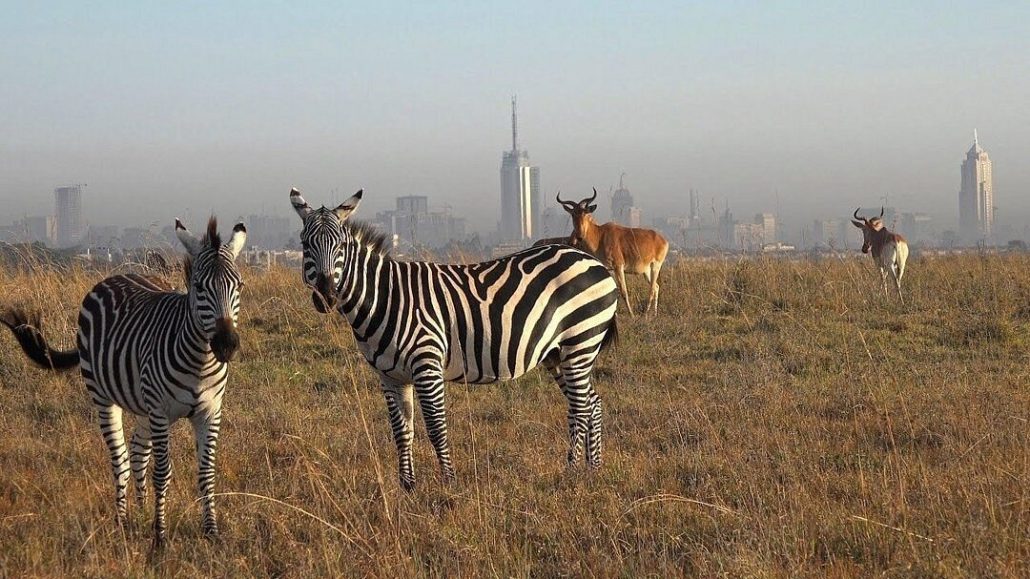Nairobi National Park
Nairobi National Park, established in 1946, is a remarkable wildlife sanctuary located just 7 kilometers (4 miles) from Nairobi’s bustling city center, making it one of the world’s most accessible national parks. Spanning over 117 square kilometers (45 square miles), the park is a unique blend of savannah, grassland, and wetlands, providing a refuge for a variety of wildlife amidst the urban landscape. Nairobi National Park is renowned for its stunning contrast of wildlife against the backdrop of the city skyline, offering visitors a unique opportunity to experience the beauty of nature without leaving the capital.

The park’s proximity to Nairobi makes it a popular destination for both tourists and locals, providing an escape into the wilderness. It is also significant for conservation efforts, serving as a breeding ground for endangered species and as a crucial wildlife corridor. Nairobi National Park is not just a haven for wildlife; it also plays a vital role in educating the public about conservation and the importance of preserving natural habitats.
Scenery
The scenery in Nairobi National Park is a fascinating mix of open grasslands, scattered acacia trees, and scrubland, interspersed with riverine forests along the park’s waterways. The park’s landscape features rolling hills and valleys, providing diverse habitats for wildlife and excellent vantage points for viewing animals.
One of the park’s most striking features is the Silole Sanctuary, which offers stunning views of the park and the city beyond. The juxtaposition of wildlife against the urban landscape creates a unique and picturesque scene, making Nairobi National Park a photographer’s paradise. The beauty of the park changes with the seasons, providing different photographic opportunities throughout the year
Wildlife in Nairobi National Park
Nairobi National Park is home to a diverse array of wildlife, making it a prime location for wildlife enthusiasts and photographers. The park is particularly famous for its population of black rhinos, which are critically endangered. Visitors can also spot a variety of other mammals, including lions, giraffes, zebras, buffaloes, and various antelope species such as Grant’s gazelle and common impala.
The park’s unique setting allows for a relatively high density of animals, and while it may not have the same concentration of large mammals as some of Kenya’s more remote parks, it offers a more intimate wildlife experience. Visitors often report seeing animals grazing against the backdrop of the Nairobi skyline, creating a surreal and memorable experience.
Birds in Nairobi National Park
Nairobi National Park is a birdwatcher’s paradise, boasting over 400 species of birds. The park’s diverse habitats attract both resident and migratory birds, making it an excellent location for birding year-round. Commonly spotted species include the African Fish Eagle, Secretary Bird, Crowned Crane, and the African Jacana.
The wetlands within the park attract a variety of waterbirds, while the open grasslands host numerous raptors and songbirds. Birding enthusiasts can enjoy guided walks and tours, allowing them to observe the incredible avian diversity in a peaceful setting.
Weather and Climate
Nairobi National Park experiences a mild, temperate climate due to its elevation at approximately 1,600 meters (5,249 feet) above sea level. The park has two distinct rainy seasons: the long rains from March to May and the short rains from October to December. During these periods, the park transforms into a lush green paradise, ideal for wildlife viewing.
Temperatures generally range from 10°C (50°F) at night to 26°C (79°F) during the day. The dry months, from June to September, offer the best wildlife viewing conditions as animals congregate around water sources. Visitors should prepare for fluctuating temperatures and bring both light clothing for the day and warmer layers for cooler evenings.
Getting To Nairobi National Park
Nairobi National Park is conveniently located just a short drive from the city center. Visitors can reach the park by private vehicle, taxi, or ride-sharing services. The main entrance to the park is well-marked, and the roads leading to it are generally in good condition.
For those arriving by air, Jomo Kenyatta International Airport (NBO) is the nearest major airport, located about 15 kilometers (9 miles) from the park. From the airport, visitors can easily access the park via taxi or organized transport.
Park Rules
To ensure the safety of visitors and the protection of wildlife, Nairobi National Park enforces several important rules:
- Wildlife Interaction: Maintain a safe distance from all animals; feeding or provoking wildlife is strictly prohibited.
- Stay in Vehicles: Remain inside your vehicle during game drives, except in designated areas.
- Fires: Open fires are not allowed within the park to prevent wildfires.
- Noise Levels: Keep noise to a minimum to avoid disturbing wildlife and other visitors.
- Littering: Dispose of all waste responsibly; littering is prohibited and punishable by law.
Attractions To see in Nairobi National Park
Nairobi National Park is a unique destination that offers a variety of attractions, making it a must-visit for wildlife enthusiasts, photographers, and families alike. Here are some of the park’s key attractions:
- Diverse Wildlife: The park is home to an impressive array of wildlife, including the endangered black rhino, lions, giraffes, buffaloes, and various antelope species. Visitors have the opportunity to observe these animals in their natural habitat, often just a short distance from the city.
- Birdwatching Paradise: With over 400 bird species recorded, Nairobi National Park is a haven for birdwatchers. The park’s varied ecosystems support both resident and migratory birds, including the African Fish Eagle, Secretary Bird, and various waterfowl. Birdwatching tours are available, offering enthusiasts a chance to spot these beautiful avian species.
- The Nairobi Animal Orphanage: Located within the park, the Nairobi Animal Orphanage is dedicated to the rescue and rehabilitation of injured and orphaned wildlife. Visitors can learn about conservation efforts and see various animals, including cheetahs, lions, and hyenas, up close. The orphanage provides an educational experience that highlights the importance of wildlife protection.
- The Giraffe Centre: Though not located within the park itself, the nearby Giraffe Centre is an excellent complement to a visit to Nairobi National Park. It offers a chance to learn about the endangered Rothschild’s giraffe and even feed them. It’s a fun and educational experience for families and children.
- Scenic Views and Photography: The park’s stunning landscapes, characterized by rolling hills, open grasslands, and acacia trees, create beautiful scenery for photography. The juxtaposition of wildlife with the Nairobi skyline provides a unique backdrop that is unlike any other national park in the world. Early morning and late afternoon light offers the best conditions for capturing stunning photographs.
- Educational Programs and Guided Tours: Nairobi National Park offers a range of guided tours and educational programs aimed at promoting conservation awareness. These tours provide insights into the park’s ecology, wildlife behaviors, and the importance of preserving Kenya’s natural heritage.
- Cultural Experiences: Visitors have the opportunity to engage with local communities around the park, learning about their cultures, traditions, and efforts in conservation. This cultural aspect enhances the overall experience and fosters a deeper appreciation for the region’s biodiversity.
- Convenient Location: The park’s proximity to Nairobi makes it easily accessible for both short visits and extended explorations. This accessibility allows visitors to enjoy wildlife experiences without venturing far from urban comforts.
Activities to Engage In Nairobi National Park
Nairobi National Park offers a variety of activities to enhance visitors’ experiences:
- Game Drives: Explore the park’s diverse wildlife on guided or self-drive game tours, taking advantage of early mornings and late afternoons when animals are most active.
- Bird Watching: Join guided birding tours to spot the park’s incredible avian diversity, especially during the migration seasons.
- Walking Safaris: Participate in guided walks to learn about the park’s flora and fauna while enjoying a more intimate experience with nature.
- Picnicking: Designated picnic areas allow visitors to enjoy meals in the scenic surroundings of the park.
- Cultural Visits: Engage with local communities near the park to learn about their cultures and conservation efforts.
Safety and Vaccination
While Nairobi National Park is generally safe for visitors, it is important to take standard precautions when exploring the park and the surrounding areas. Travelers should remain vigilant and follow guidelines provided by park rangers and guides. It is advisable to stay within designated areas and avoid approaching wildlife too closely.
Before traveling to Kenya, it is recommended to consult with a healthcare professional regarding vaccinations. Yellow fever vaccination is mandatory for travelers arriving from endemic areas, while other vaccinations for hepatitis A, typhoid, and rabies may also be advisable. Additionally, malaria is present in some regions of Kenya, so taking antimalarial medications may be prudent, especially during the rainy seasons.
Nairobi National Park stands as a testament to Kenya’s commitment to wildlife conservation and environmental preservation, providing an extraordinary experience just outside the bustling capital. With its unique blend of urban and natural landscapes, diverse wildlife, and numerous activities, the park offers visitors an unforgettable glimpse into Kenya’s rich biodiversity and natural beauty.
